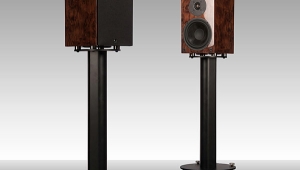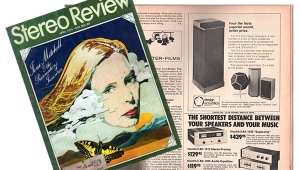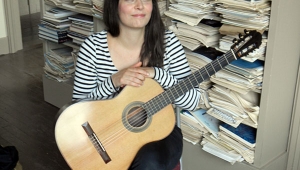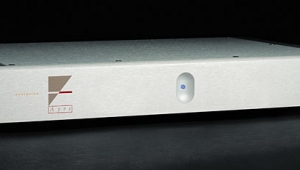| Columns Retired Columns & Blogs |
The Fifth Element #31
Firms that specialize in architectural acoustics usually concentrate on the big jobs—churches, schools, and auditoriums. Rives Audio is unusual in that they specialize in "small-room" acoustics, for residential listening rooms and home theaters. Rives is unusual in another way: they consult on a nationwide and even international basis.
Footnote 1: Chris Huston played lead guitar in The Undertakers, one of the favorite bands of Huston's Liverpool College of Art classmate John Lennon. Soul singer Jackie Lomax was later a member of the group, and George Harrison was a big fan. Huston's other credits include the engineering of Led Zeppelin II. Color me impressed.—John Marks

In addition to offering consulting and room-design services, Rives Audio sells the PARC, a three-band parametric analog equalizer specifically designed to address problematic bass modes in home environments, and which received a Stereophile "Product of the Year" award in 2003.
Immediately after Home Entertainment 2005, company founder Richard Rives Bird took some time to discuss with me how you can get more out of your audio system by paying attention to room acoustics.
John Marks: How did you get started doing this?
Richard Rives Bird: My educational and professional background is in physics, but music is my real love. I play the piano daily for 30 minutes to an hour, and I take weekly lessons with an extraordinary jazz pianist, Dan Knight.
For the first 10 years after graduate school, I worked as a medical physicist for a few X-ray equipment manufacturers. I was working for a startup company, and I found myself with spare time on my hands. I started educating myself on acoustics by reading books, journals, and online papers. I found the math to be pretty straightforward, and started applying concepts to my own listening room.
I had been an audiophile for years. I had very good equipment, and while the room was good, it was also the limiting factor. My biggest problem was the bass response. My room had two dimensions that were nearly identical, and I had the bass-mode blues. I used a McIntosh equalizer to fix that problem, but it was rather noisy and had fixed Q values. I looked at the market and didn't find any analog EQ devices that could solve such problems, so I decided to design one and build it. That was the beginning of PARC [parametric adaptive room compensation]. I recognized early on that if you didn't get the bass right, little else would matter, and the nonelectrical fix—cumbersome, large bass traps—rarely solved the problem effectively, and certainly were an eyesore.
So my next step was to determine exactly what the business would do. While I expected the PARC to be a fantastic product, we all know that building a company on one product is not wise. I also examined the issues that I had dealt with in my own room—they weren't just the bass issues. The biggest initial frustration I had with my own room was that I knew it had significant acoustic issues, but I had no place to go to get help. There were no cost-effective consultants out there who could show me what I needed to do to correct the problems. I had to fix my room on my own. It took a lot of time, a lot of research, and a fair amount of expense, as the first steps were a bit of trial and error.
I felt this was what the market really needed—a solution to all those rooms that had problems. And there's no one solution—there is no magic bullet to room acoustics. What I really wanted to do was provide a full answer to residential room acoustics. The PARC is just one tool that helps us to that end. The main part of the business is acoustical engineering and design services. We design listening rooms, media rooms, and home theaters worldwide now, very cost-effectively, through our dealer network.
JM: What are the differences between small-room acoustics and church and auditorium acoustics?
RRB: The problem areas are very different for large-room [church and auditorium] acoustics compared to a small room. In a small room, you are most concerned about room modes that create boomy, muddy bass; hence, the design of the PARC. In large rooms, you typically have just the opposite problem—not enough bass—and are more focused on slap-echo issues.
JM: When did you form your company?
RRB: The company was officially formed in April of 2002.
JM: What was its growth like?
RRB: At first, growth was slow. I can recall my first Home Entertainment Show in New York, just after the company was officially formed. We didn't exhibit, but we were there. I met Chris Huston at that show, and he told me he also designed theaters and studios and might be able to help me. We started talking, and I looked into his background further. I discovered this guy had a huge amount of practical experience, and all his clients loved him. Chris started working with us almost immediately on a contract basis. He is now VP of Acoustical Engineering for Rives Audio. Our website has a page dedicated to his history—and it's worth taking the time to visit it (footnote 1).
Shortly after the Show I got a call from John Atkinson. He suggested that Stereophile review the PARC. Kal Rubinson wrote the review, and one result was a "Product of the Year" award from Stereophile. That really helped the overall credibility of the company, and increased awareness of acoustics.
JM: What was your personal on-the-job learning curve like?
RRB: Never-ending. I learn all the time—about everything.
JM: How many audiophiles have you advised?
RRB: I lost count a long time ago. We do an average of about 25 designs a month now, so it's been hundreds.
JM: Has there been anything common to the home-audio situations you've faced?
RRB: There's not any one consistent thing, which is why everything is custom. We start with an application form, so we can understand our client's needs. What is consistent is that certain issues need to be dealt with, if only to establish that they are nonissues. For example: Is sound isolation important? Is the room for two-channel or home theater? How many people need to be seated? Our form gathers this information, and then we design accordingly. For the person who wants great two-channel sound—but whose room serves both for two-channel and for home theater—we provide a design that is optimized for two-channel, and its home-theater sound will still be pretty good. However, if you damp a room for optimal home-theater surround sound, the room is usually too dead for good two-channel sound. Aesthetics or spousal acceptance is another issue that we have to accommodate regularly. Many of our clients do not have dedicated rooms, and we need to design accordingly.
JM: I am not going to ask you to tell us about the dumbest thing you have ever seen, because that person might recognize himself, but: what is the most common acoustical sin of omission that audiophiles commit?
RRB: Well, the biggest is just ignoring the subject altogether. If you look at our website, we have a huge amount on education regarding acoustics. I would rather help someone do it himself or herself than ignore the subject. Acoustics seems daunting for one to take on alone, but it's not that hard to get the basics right. That won't be as good as an engineered room, but it sure will be better than doing nothing. The second thing we see is someone will go out and buy a few absorbing panels and put them in the room and think, "Wow, that sounds a lot better—I should go buy at least 50 more, and fill up my room." That logic doesn't work in acoustics, and is expensive for the novice. If you are going to do it yourself, take it slow, one small step at a time, and you will get good results over time.
Footnote 1: Chris Huston played lead guitar in The Undertakers, one of the favorite bands of Huston's Liverpool College of Art classmate John Lennon. Soul singer Jackie Lomax was later a member of the group, and George Harrison was a big fan. Huston's other credits include the engineering of Led Zeppelin II. Color me impressed.—John Marks
- Log in or register to post comments




































